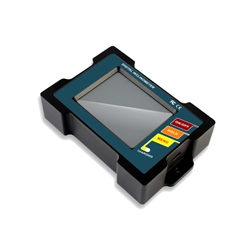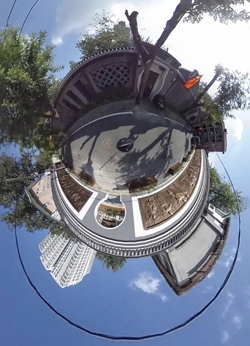Digital inclinometers represent a transformative leap in the realm of angle and slope measurements. Unlike traditional analog inclinometers, their digital counterparts utilize advanced sensor technologies to provide highly accurate and reliable readings. These devices have found widespread applications across diverse industries, ranging from construction and engineering to aerospace and geophysics.
Digital inclinometers typically employ sophisticated sensors, such as accelerometers and gyroscopes, to detect angular changes with exceptional precision. The data collected is then processed digitally, allowing for quick and accurate readings. This departure from traditional mechanical methods not only enhances accuracy but also enables real-time monitoring capabilities, a feature integral to many modern applications.
Significance of Selecting the Right Device
The importance of choosing the right digital inclinometer cannot be overstated, given its pivotal role in various sectors.
Precise Measurements: The primary function of a digital inclinometer is to provide precise measurements of angles and slopes. In industries where accuracy is paramount, such as construction and engineering, relying on a high-quality digital inclinometer ensures that measurements are not only correct but also consistent.
Real-time Monitoring: The ability to monitor angles and slopes in real-time is a game-changer. In applications like structural monitoring or vehicle navigation, having immediate access to accurate incline data allows for prompt adjustments and decision-making, contributing to safety and efficiency.
Application-Specific Needs: Different industries and projects have unique requirements. A digital inclinometer must be selected based on the specific demands of the application at hand. For instance, the inclinometer used in aerospace applications may need to meet different criteria compared to one employed in geological surveys.
Factors to Consider
Application Requirements
Construction and Engineering
In the realm of construction and engineering, the use of inclinometers is paramount for ensuring the stability and integrity of structures. The inclinometer needs in construction projects extend to monitoring slopes, angles, and ground movements. For example, during the construction of buildings or bridges, precise incline measurements can help detect any shifts or deviations from the planned angles. This application aids in preventing potential structural issues, enhancing safety, and facilitating accurate project execution.
Aerospace and Aviation
In aviation applications, precision is not merely a preference but an absolute necessity. Inclinometers play a critical role in ensuring the proper alignment and orientation of aircraft during flight. The data provided by inclinometers is vital for pilots to maintain optimal angles of ascent, descent, and bank. In this context, the inclinometer contributes directly to flight safety and operational efficiency. A minor deviation from the correct inclination can have significant consequences, making the selection of a highly accurate inclinometer crucial in aviation.
Geophysics and Exploration
In the field of geophysics and exploration, inclinometers are invaluable tools for studying the Earth's surface and subsurface. These devices aid in measuring the inclination of geological formations and detecting potential shifts or changes in topography. Inclined boreholes equipped with inclinometers are commonly used to study rock layers, fault lines, and underground structures. The data obtained contributes to a better understanding of geological processes, aiding in resource exploration and natural hazard assessment.

Accuracy and Precision Needs
High Accuracy vs. Standard Precision
Choosing between high accuracy and standard precision involves a careful consideration of project requirements. High accuracy is indispensable in applications where minimal deviations can have significant consequences, such as in aerospace or certain engineering projects. Standard precision, while less demanding, may be suitable for applications where a lower degree of accuracy is acceptable. Weighing the pros and cons involves assessing the cost implications against the potential risks and benefits associated with the level of accuracy required for a specific project.
Impact on Decision-Making
The level of accuracy in inclinometer measurements directly influences decision-making processes. In scenarios where split-second decisions are critical, such as in aviation or emergency response situations, having highly accurate inclinometer data is imperative. Conversely, for less time-sensitive applications, standard precision may suffice, allowing for a more cost-effective solution without compromising overall project success. Understanding how accuracy impacts decision-making is pivotal in aligning inclinometer choices with project priorities.
Budget Constraints
- Balancing Cost and Quality: Balancing cost and quality is a delicate yet crucial aspect of inclinometer selection. While high-quality, highly accurate inclinometers often come with a higher price tag, it's essential to evaluate whether the added precision justifies the additional cost for a particular project. Assessing the specific needs of the application against budget constraints ensures that the chosen inclinometer meets both accuracy requirements and financial considerations.
- Long-term Investment Considerations: Viewing the selection of a digital inclinometer as a long-term investment involves considering not only the initial purchase cost but also the potential savings and benefits over the device's lifespan. High-quality inclinometers, although initially more expensive, may offer greater durability, reliability, and extended service life. Evaluating the long-term benefits, such as reduced maintenance costs and increased project efficiency, aids in making informed decisions that align with both immediate budget constraints and future project considerations.
Types of Digital Inclinometers
Single-Axis vs. Multi-Axis
Advantages and Disadvantages:
Single-Axis Inclinometers
Advantages

- Simplified design, often more compact.
- Cost-effective for applications requiring measurement along a single plane.
- Typically have lower power consumption.
Disadvantages
- Limited to measuring inclination along one axis.
- May not provide a comprehensive view of complex orientations.
Multi-Axis Inclinometers
Advantages
- Measure inclination along multiple axes, providing a 360-degree view.
- Suitable for applications where orientation in multiple directions is crucial.
- Greater versatility for diverse projects.
Disadvantages
- Generally larger and more complex in design.
- Higher power consumption compared to single-axis counterparts.
Choosing Based on Application
The choice between single-axis and multi-axis inclinometers depends on the specific requirements of the application.
- Single-Axis: Ideal for applications where inclination is primarily along one plane, such as monitoring the tilt of a platform or ensuring a specific slope.
- Multi-Axis: Suited for projects demanding a comprehensive understanding of spatial orientation, like robotics or complex structural monitoring.
MEMS vs. Gyroscopic Sensors
Understanding the Technology:
MEMS (Micro-Electro-Mechanical Systems) Sensors:
- Utilize microscale components to measure changes in capacitance, resistance, or other properties.
- Advantages include smaller size, lower power consumption, and cost-effectiveness.
- Commonly used in consumer electronics, automotive systems, and portable devices.
Gyroscopic Sensors
- Rely on the principles of angular momentum to measure changes in orientation.
- Provide accurate measurements but are often larger and more power-hungry than MEMS sensors.
- Widely employed in aerospace, navigation systems, and applications requiring high precision.
Suitability for Different Environments:
MEMS Sensors
- Well-suited for environments with space constraints and power limitations.
- Excel in applications where size, weight, and power efficiency are critical factors.
- May be preferred in consumer electronics, wearables, and projects with limited physical space.
Gyroscopic Sensors:
- Thrive in environments where high precision and stability are paramount.
- Commonly used in aerospace and defense applications where accuracy is crucial for flight control and navigation.
- Suitable for large-scale industrial applications where size and power consumption are less restrictive.
Contact us at sisco for more information about the digital inclinometer.

